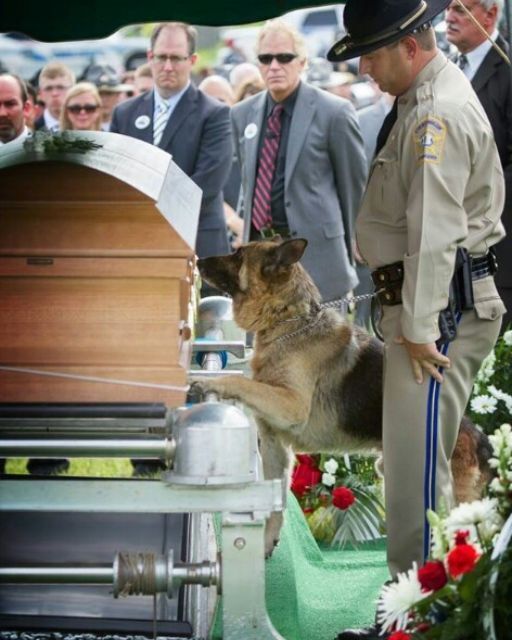HE WOULDNT LEAVE THE CASKET, NOT UNTIL HE COULD SMELL THE TRUTH

They said the dog hadn’t eaten in four days. For four long days, he paced and whimpered by the front door, ignoring every gentle attempt to pull him away. Then this morning, they finally loaded him into the patrol car one last time—and he jumped in as if he knew exactly where he was headed.
The ceremony was quiet and respectful, with polished badges and neatly folded flags. I stood near the back, not entirely part of the crowd yet unable to tear myself away. I had seen them together so many times—officer and dog, working as if they shared one unbreakable bond. Everyone spoke of the K9’s training and discipline, but I remembered the loyalty in his eyes; the way he fixed his gaze on his handler as if nothing else in the world mattered until he received a command.
Now, there he was, front paws resting on the casket and his nose pressed against the wood. He wasn’t barking or growling—he was simply sniffing, moving slowly as if trying to make sense of something that defied explanation. His handler, struggling to keep hold of the leash, had white-knuckled grief etched on his face. The dog, however, seemed oblivious or perhaps indifferent, his focus solely on piecing together the mystery before him.
That mystery was one no one dared speak of. His partner, Officer Silas, wasn’t scheduled for duty that night. The call that led him to his fate had vanished from the records, and the last radio transmission—so unlike his voice—remained unexplained. Then, as if confirming our worst suspicions, the dog emitted a low, sharp whine. That’s when I noticed it: a small scrap of folded fabric wedged behind the base of the casket. It wasn’t from his uniform. It was a darker blue, made of a different material, and carried an acrid scent of burnt metal and something else I couldn’t identify. In that moment, I realized something was terribly wrong.
The following days blurred together. I wasn’t a cop—just a local journalist—but my gut told me this story was bigger than anyone realized. I began to dig, pulling strings and asking questions. Most people urged me to let it go, to accept the tragedy for what it was. But Valor, the German Shepherd whose loyalty to Silas was legendary, wouldn’t let the matter rest. Back at the precinct, he paced restlessly around his handler’s empty desk. Other officers tried to comfort him, but he remained inconsolable—as if he knew a truth we were all missing.
After gaining access to the radio logs and official reports, I discovered something unsettling. The last call—the one that supposedly sent Silas to his death—was flagged as a “phantom call.” There was no originating address, no caller ID; just a garbled message and a location. That location turned out to be an abandoned warehouse on the edge of town, a notorious haven for illegal activities. Yet no evidence of any incident, no witnesses, no trace of Silas—only silence.
I traced the mystery of the fabric scrap to the local uniform supplier. They confirmed that the material was custom-made and used exclusively by a private security firm, not by the police. That was the turning point: Silas hadn’t been killed by chance. He had been targeted, and someone had gone to great lengths to cover their tracks.
Determined to uncover the truth, I ventured to the warehouse. The air was cold and damp, thick with decay. Valor, somehow slipping past the precinct’s security, was already there, sniffing around a shadowed corner with his tail low and ears alert. I followed him to a hidden room behind a false wall. Inside, a computer, a radio transmitter, and a pile of burnt documents lay scattered. The stench of burnt metal was overpowering.
With help from a tech-savvy friend, I bypassed the password on the computer. What I uncovered was chilling: Silas had stumbled upon a network of corruption involving local officials and the very private security firm whose material we had found. The phantom call was a setup—a manipulated radio transmission designed to mimic Silas’s voice and lure him into a trap. They believed they had erased every trace of their crime, but they had underestimated Valor’s loyalty and instincts.
Valor had picked up on a faint, almost imperceptible scent—a specific wood polish used only on the handles of a custom-made baton, a set favored by the leader of the security firm. Following this secondary scent, the dog led me to a hidden compartment in the security firm’s office. There, I uncovered the missing radio logs, the original call, and even a recorded confession from Silas made just moments before his death. He had known they were coming for him.
In the end, the police reopened the case. The corrupt officials and the security firm were brought to justice, and Valor, the loyal K9, emerged as an unexpected hero. This ordeal taught me that even in the darkest circumstances, truth finds a way to surface. Loyalty—especially from an animal—can be an unyielding force, capable of revealing secrets that humans often overlook.
Never underestimate the power of intuition, the importance of loyalty, and the relentless pursuit of truth. Even when the odds seem insurmountable, keep digging, keep questioning, and trust your gut. If this story resonated with you, please share it. Your support helps keep these truths alive.